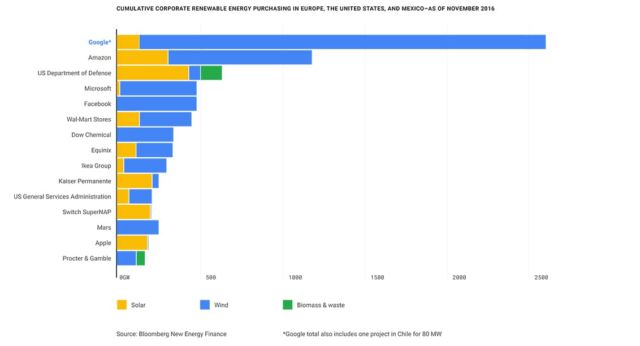
Google has announced it will power its entire global operations using energy from renewable sources next year.
In a move that the search and advertising giant is hailing as "a huge milestone," 100 percent of the 2600 megawatts or so that Google's parent company Alphabet needs to power its data centres and offices around the world will be acquired by solar or wind energy.
Google is already the world's largest private buyer of energy from renewable sources, leaving Amazon in a distant second, and it used renewables to meet 44 percent of its needs last year. The decision has been taken in part for cost reasons, as the price of renewables has recently tumbled, but its European head of energy Marc Oman insisted that it isn't "about greenwashing" (or presenting an environmentally responsible image).
“We are convinced this is good for business, this is not about greenwashing," Oman told the Guardian. "This is about locking in prices for us in the long term. Increasingly, renewable energy is the lowest cost option. Our founders are convinced climate change is a real, immediate threat, so we have to do our part.”
Of course, Google won't literally just be using energy generated from wind and solar farms; the nature of national grid infrastructures prevents that. Instead, it will be paying for enough units to account for its usage in a carbon-offsetting programme.
"To reach this goal we’ll be directly buying enough wind and solar electricity annually to account for every unit of electricity our operations consume, globally," said Urs Hölzle, Google's senior VP of technical infrastructure, in a blog post on the initiative. "We're focusing on creating new energy from renewable sources, so we only buy from projects that are funded by our purchases."

The costs of wind and solar have fallen by 60 percent and 80 percent respectively in the past six years, he said, and Google now buys energy from 20 renewable projects around the world, including sites in Sweden, the Netherlands, and Chile. "Electricity costs are one of the largest components of our operating expenses at our data centres," Hölzle continued. "Having a long-term stable cost of renewable power provides protection against price swings in energy."
Hölzle wrote that the 100 percent renewable target, which Google first set itself in 2012, "is just the first step":
As we look to the immediate future, we’ll continue to pursue these direct contracts as we grow, with an even greater focus on regional renewable energy purchases in places where we have data centres and significant operations. Since the wind doesn’t blow 24 hours a day, we’ll also broaden our purchases to a variety of energy sources that can enable renewable power, every hour of every day.
This could mean, according to Oman's comments to the Guardian, opening up to other renewable sources, including hydro power, biomass, or even nuclear:
We want to do contracts with forms of renewable power that are more baseload-like, so low-impact hydro; it could be biomass if the fuel source is sustainable, it could be nuclear, God forbid, we’re not averse. We’re looking at all forms of low-carbon generation.
We don’t want to rule out signing a nuclear contract if it meets our goals of low price, safety, additionality and in a sufficiently close grid, we don’t want to rule that out, but today we can’t positively say there are nuclear projects out there that meet this criteria.
Listing image by Bureau of Ocean Energy Management
reader comments
63